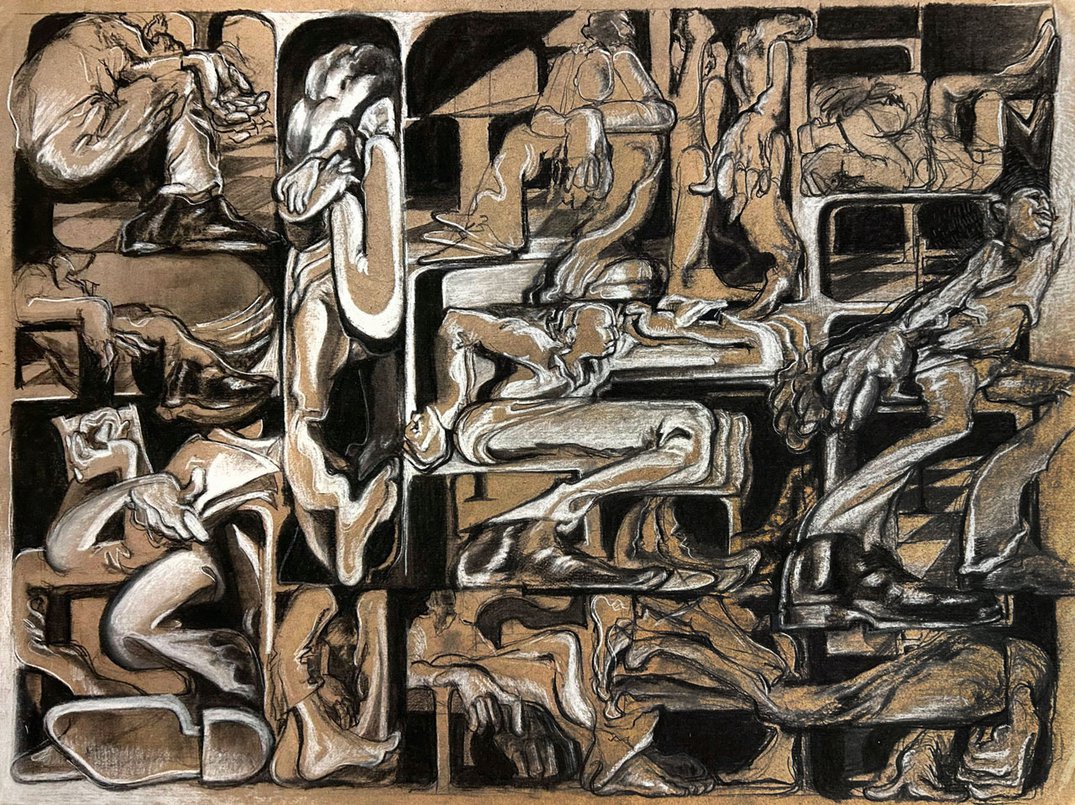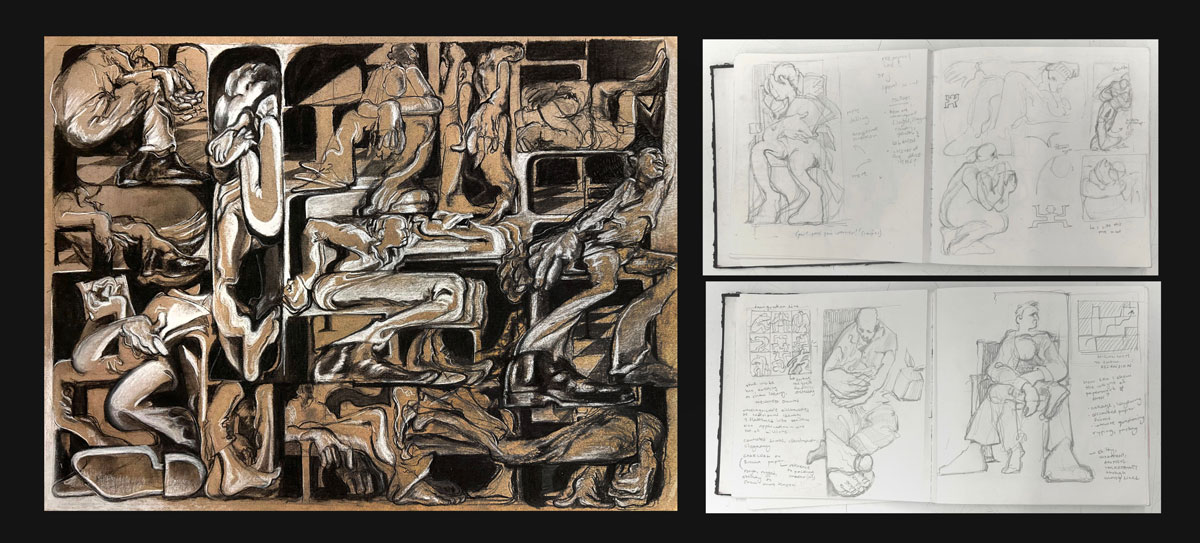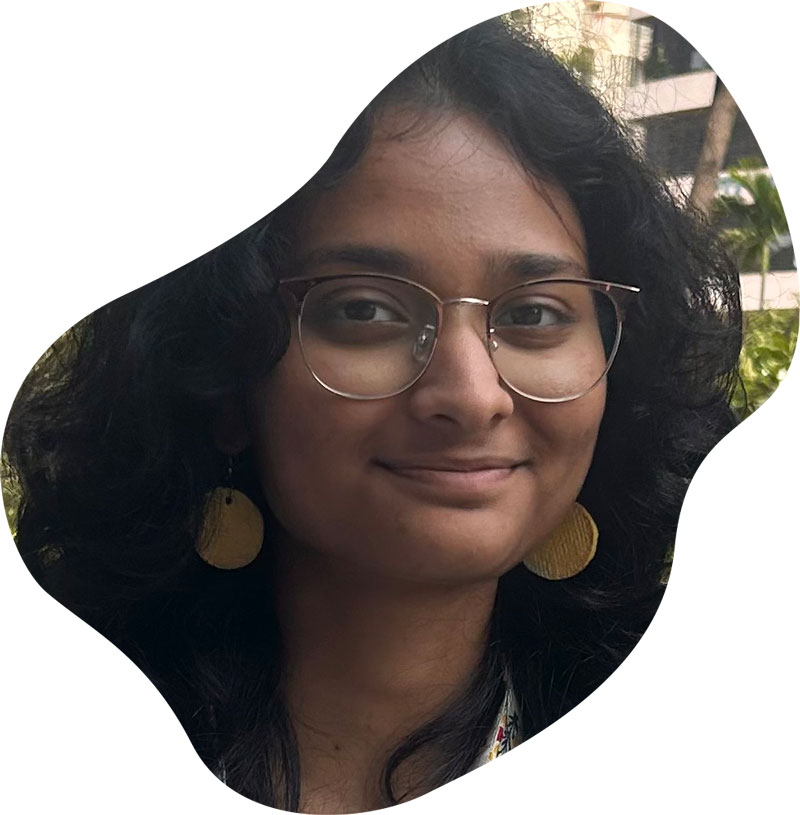

The Immigration Queue

Height: 16.5" x Width: 24" | Material(s): Charcoal on brown paper | Process(es): Exaggerated weight and contorted limbs, highlighted the relief of eventual escape from unending wait | Citation(s): Referred to poses from sketchbook exploration. | Idea(s): Sickening yellows & claustrophobic compositions relay anxiety & stress | Curatorial Note: This is a powerful composition that pulls the eye in and out of the grid-like space. Very strong mark making that strengthens the narrative.
Zoya Gupta
Does your work reference or draw on a contemporary or historical artmaking style, practice, or tradition? If so, please explain.
My work draws on my exposure to experimentation with the human form. I'm influenced by Francis Bacon's take on the distortion of human anatomy, as well as the tenderness in the figurative paintings by Asian contemporary artists like Sudhir Patwardhan, Liu Xiaodong, and Gan Chin Lee in reflecting the immigrant diaspora of their cities.
Please describe the context for how the idea for this artwork originated (was this part of your sustained investigation, an independent project, a class assignment, created during a summer study, etc.).
“The Immigration Queue” was born from my family's experiences during our first year in the United States. Later, it sparked and guided my sustained investigation into tracing the “anatomy of dislocation and relocation.” Each piece studies the physical and psychological strain imposed by change—how it seeps into our bodies and reshapes how we connect with the spaces around us, through organic yet disturbingly distorted anatomy. At its core, this series consists of my observations of my family, especially my father, who often downplays his personal struggles to cope with transition. Faceless figures clutching identification records blend with intimate portraits of my family, balancing the universal and deeply personal. In this process, identities dissolve into the broader yet oversimplified “immigrant experience.”

I explored immigration through different stages of dislocation and relocation. The mental strain of moving manifests in the physical body and its interaction with one's environment and belongings. The struggle to hold on to cherished memories during the process of packing-unpacking and starting afresh in a new land captures contradictory feelings of uncertainty and hope characteristic of the broader immigrant experience, and my own.
In what ways did you practice and experiment when developing your sustained investigation?
Throughout the creative process, my sketchbook has been my closest companion. Developing my interest in observational sketching and anatomy, I'd revise figure studies and sketches into more stylized forms by exaggerating movement, proportions, and perspective, and squeezing these figures into rigid spaces. I adopted this abstraction into the compositions of my pieces by retaining the same expressiveness and spontaneity as was in my sketchbook.

Material(s): Charcoal on brown paper | Process(es): Exaggerated weight and contorted limbs, highlighted the relief of eventual escape from unending wait | Citation(s): Referred to poses from sketchbook exploration. | Idea(s): Sickening yellows & claustrophobic compositions relay anxiety & stress. | Curatorial Note: The sketchbook shows us how well thought-out and organized this image is.
How did your materials and process(es) choices shape the creation or meaning of your artwork(s)?
My process emphasized spontaneity, which naturally led me to charcoal and acrylic paint. Both these mediums are quick and capable of being layered. Charcoal can be softened by blending and erasing, but with black and white, it can create sharp contrasts. Similarly, acrylic paint can capture warmth, but its shocking vibrancy can convey an irreplicable artificiality. The versatility of these mediums was essential in studying the contradictions inherent in the immigrant experience. Uncertainty, anxiety, hope and relief—all find themselves within their various shades.
How did your art teacher support your artistic development?
With my art teacher's support, I learned to trust myself and my instincts. In times when I'd find myself stuck going in circles, he nudged me towards creating. I often sought the perspectives of the rest of the art department, whose interpretations of my work and personal experiences contributed to my journey.
What is your advice to other AP Art and Design students?
During the course, there were several periods where I found myself overwhelmed by inertia. It was often thanks to rediscovering inspiration through my peer group's works that I got back into drawing and painting. My most heartfelt advice to fellow students would be to remain spontaneous and open: Keep sketching, creating, and making, and don't hesitate to seek help, inspiration, and support from the community around you.
Nathan Leventhal
West Windsor-Plainsboro High School South, West Windsor, NJ, USA
Teacher statement
Teacher statement
The AP Art and Design course supports inquiry-based personalized learning in the sustained investigation portfolio component. What strategies helped you guide students through inquiry?
We start with a number of generalized prompts with large amounts of room for interpretation. We discuss the potential of continuing to investigate any of these in subsequent pieces. We discuss how artists who are familiar to them have underlying concepts and concerns that drive their work and investigation. We discuss what choices they've been making and how that could be personal concerns and interests that could drive a sequence. Then we make. Then we reinterpret a past piece. Then we think of pathways that diverge from or continue based upon their strengths and the things we discover. Repeat.
How did you scaffold writing into the art-making and thinking processes?
In the beginning, we start with sketchbook work. Then there are reports where they select artists who they respect and admire, and they analyze their style and what is inspirational for them from these artists. We do verbal and written critiques. They describe the ideas and approaches they use for each work and turn it in with their work. When they start their concentrations in earnest, they do semiweekly "where am I and where am I going" logs that describe what they've been doing, what they've learned, and where they plan to go from there.
How did you support skill development AND inquiry in the AP Art and Design curriculum?
Skill development is secondary in our course and is driven by the student, their particular needs, and what/how they want to convey the messages and content to their viewer. Generally, the student leans into the strengths they already have and fills in gaps of knowledge as needed.
How did you structure practice, experimentation, and revision into your AP Art and Design curriculum?
I expect students to use their sketchbooks weekly to generate and flesh out their ideas. It also gives them a place to store source material and explore potential outcomes. The class has ample time for experimentation with media and materials, and process critiques give them opportunities for feedback and for sharing their views and knowledge with each other. Formal critiques give more finished feedback, but they are allowed to take their pieces and rework them in response if desired. They can also rework pieces after they have been graded and we talk about them.
How do you support your students in the Selected Works portfolio component?
We generally put everything they've made out and put it an order that best represents their investigation path and learning. We cut out pieces that might be redundant, or outliers that distract from the general movement. They then take the pieces they are most proud of for their focal pieces.
What did you learn from working with your student?
Zoya is phenomenal at assimilation. She is both left- and right-brain strong, and she is always thinking about everything. She balances the composition, the concept, and technical skills and makes it look easy... but mainly because she puts so much work into it. She is an inspiration to the other students and me as well.
Zoya Gupta



